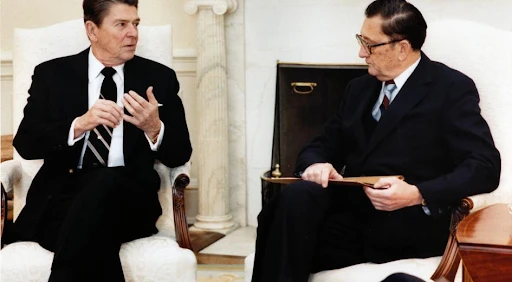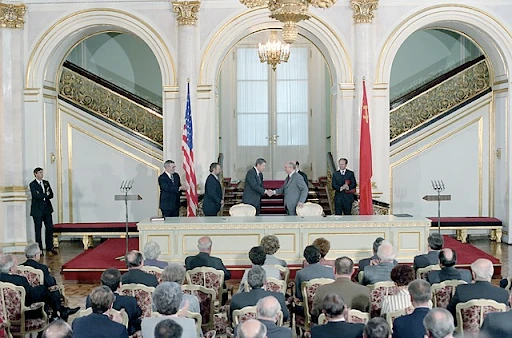The 45-year-long Cold War of protracted geopolitical contention between two global powerhouses helped determine the unprecedented magnitude of nuclear weapons around the world. Treading into the unknown waters of global nuclear warfare, the United States and the Soviet Union made great strides in negotiating nuclear disarmament in Höfði, a private estate in Reykjavík, Iceland. President Ronald Reagan and Soviet Premier Mikhail Gorbachev’s meeting followed suit of the successful 1985 Geneva Summit and continued the dialogue about curbing intermediate missile arsenals in Europe.
The Reykjavík Summit implied progress in negotiations; however, it did not produce the American-desired outcome of eliminating all nuclear weapons in Europe. Reagan and Gorbachev would meet twice again after Reykjavík, in Washington and Moscow, ultimately leading to the signing of the Strategic Arms Reduction Treaty (START I) in July of 1991 between President George H.W. Bush and Gorbachev. This treaty would limit the deployment of nuclear warheads and intercontinental ballistic missiles (ICBMs) amongst its signatories, ensuring the cessation of the Cold War.
Edward L. Rowny was a lieutenant general and military advisor to five U.S. presidents and the backbone of START I’s development as chief negotiator under President Reagan. Rowny was a decorated commanding officer in World War II, the Korean War, and the Vietnam War. His accolades and commendations as special advisor for arms control during the tail end of his career deemed him a “chief architect of peace through strength.”

Rowny possessed negotiating and advising skills that were unparalleled in the U.S. Department of State, and his extensive military experience allowed him to make a valuable impact as a cornerman championing the stars and stripes in the ring of the Cold War.
Rowny explains the inner workings of diplomatic brilliance on both sides to initiate the conclusion of the Cold War during the Reykjavík Summit and the subsequent years pushing for the signing of START I. His account provides an individualized perspective on U.S.-Soviet disarmament negotiations and embodies the might of constructive diplomacy.
Edward L. Rowny’s interview was conducted by Charles Stuart Kennedy on July 2, 2000
Read Edward L. Rowny’s ADST oral history HERE and the Army Corps of Engineers oral history HERE
Drafted by Lucas Souza
ADST relies on the generous support of our members and readers like you. Please support our efforts to continue capturing, preserving, and sharing the experiences of America’s diplomats.
Excerpts:
“We developed with great care a reply designed to smoke out whether the Soviets were indeed serious about eliminating all nuclear weapons.”
Gorbachev’s Arms Proposal:
Early in 1986, Gorbachev seized the initiative in arms control. He called for the elimination of all nuclear weapons by the year 2000. The proposal was obviously designed for its propaganda effect, made obvious by the fact that Gorbachev made his proposal public. Clearly, the Soviets were making an offer only for its effect on world opinion. Gorbachev also proposed that only U.S. intermediate-range missiles in Europe be reduced and not also British or French missiles. This, if it came to pass, would be a monumental breakthrough.
The dilemma facing Reagan was how to deal with Gorbachev’s proposal. Should it be dismissed simply as a propaganda ploy? Or would it be better to counter it with a concrete, detailed U.S. proposal? The President chose the second approach. As a result, we developed with great care a reply designed to smoke out whether the Soviets were indeed serious about eliminating all nuclear weapons. We also welcomed the prospect of eliminating intermediate-range missiles.
“I became nervous, hoping that Reagan would not get trapped. However, Reagan carefully began to extricate himself. He said that he too wished to see the eventual elimination of all nuclear weapons.”
Gorbachev’s Psychological Warfare:

In Reykjavík, true to form, Gorbachev tried to brush aside subjects related to the East-West relationship and to deal only with arms control. Once again, Reagan insisted that his broad agenda, including regional issues and human rights, be discussed. Despite repeated attempts by Reagan to engage Gorbachev on the broad agenda, Reagan did not succeed. When the two leaders got around to arms control, Gorbachev repeated the proposal he had made in January that all strategic nuclear weapons be eliminated.
He also said that the Soviets were prepared to talk in detail about START [Strategic Arms Reduction Treaty] and INF [Intermediate-Range Nuclear Forces Treaty]. Reagan suggested that arms control experts get together that evening….
By the time the session broke up at 6 a.m., we had agreed on a 50 percent reduction in strategic offensive arms in five years—a major step forward. On INF, we agreed to reduce to zero in Europe but the Soviets would not budge on reducing any missiles in Asia. The Soviets had not brought up the thorniest issue, the reduction of all nuclear weapons.
On Sunday morning, during what was to have been the final session, Reagan and Gorbachev quickly agreed to reduce strategic forces by 50 percent. In a long session on INF, Gorbachev repeated his acceptance of zero in Europe but would not budge on reducing SS-20s [“Pioneer” Russian propellent missiles] in Asia. Reagan would not agree. Much to my disappointment, since I thought Reagan would get on a slippery slope, the President proposed that the sides eliminate all offensive ballistic missiles in a 10-year period. Gorbachev countered by repeating his earlier proposal that all nuclear weapons be eliminated by the year 2000. I became nervous, hoping that Reagan would not get trapped. However, Reagan carefully began to extricate himself. He said that he too wished to see the eventual elimination of all nuclear weapons. However, he wanted an “insurance policy” which held on to air- and sea-launched cruise missiles until the conventional imbalance was redressed. Reagan said he wanted to assure there was “coupling” of nuclear and conventional forces. He said that he did not want “to make the world safe for conventional warfare.” It was a clever rejoinder, but I was still nervous. Could Reagan pull it off with Gorbachev? And if so, could he explain it to the American people?
This exchange was at the core of the controversy which the Soviets have kept alive since Reykjavík. Gorbachev subsequently repeated the assertion that Reagan assented to the elimination of all nuclear weapons. This, unfortunately, was true. But Gorbachev added that Reagan agreed to eliminate all weapons by 1996 which Reagan did not do. Reagan had proposed to eliminate all weapons eventually and only the ballistic missiles by 1996.
Reagan made it clear that his proposal to eliminate all nuclear weapons was an eventual goal. But Gorbachev attempted to use the ambiguity to embarrass Reagan. At this stage of the discussion, time was running out. The Reykjavík meeting was scheduled to end at 12:30 p.m., and it was already noon. Gorbachev showed himself to be a skillful debater and a clever tactician. He had Reagan over a barrel by proposing to eliminate all nuclear weapons and knew it. Reagan did not want to admit to Gorbachev, or to the world, that he opposed eliminating all nuclear weapons. In fact he had telegraphed to us that he would have liked to do so, but respected our opinion and took our advice. He said that it was impractical to reduce all nuclear weapons by the year 2000, that it must be an eventual goal. Reagan, to our surprise, proved he could hold his own in a debate with Gorbachev. He amazed us with his dexterity and his firmness. Reagan might just pull it off….
When the two leaders resumed that afternoon, they held to their respective positions. Gorbachev proposed that all nuclear weapons be reduced by the year 2000 and Reagan again made it clear that we proposed that only ballistic missiles be reduced by 1996. Reagan reiterated that we must hold out some nuclear weapons until the conventional imbalance had been redressed. Reagan went to great lengths to make his position clear. But Gorbachev would not acknowledge that he understood. The possibility remained that Gorbachev would try to embarrass Reagan publicly….
“The press honed in on the negative aspects of the meeting and neglected its positive aspects.”
Aftermath of Reykjavík:
Immediately after the meeting, [Former Secretary of State under Reagan] Secretary George Schultz held a press conference. Tired and frustrated that no agreement had been reached on the ABM [Anti-Ballistic Missile Treaty] and SDI [Strategic Defense Initiative] issue, and worried that Gorbachev might exploit the “elimination of all nuclear weapons” issue, Schultz painted a dark picture. Only belatedly did he say that substantial progress had been made on INF and START. The press honed in on the negative aspects of the meeting and neglected its positive aspects.

Gorbachev, in his press conference, tried to exploit the “elimination of all weapons” issue. But whereas he had been skillful in debating Reagan, he was less clear in answering press queries. He appeared tired and confused. As a result he failed to capitalize on the propaganda advantage we thought was his. The Western press, used to short, crisp answers, got lost when Gorbachev went into long-winded explanations. We felt that Gorbachev had saved us, but were still not quite certain. We advised the President to report to the American people on nationwide TV the following evening.
Following the President’s address, during which Reagan did a masterful job of emphasizing the positive aspects of Reykjavík, the press stories in the United States turned around. By the end of the week, a nationwide poll indicated that 70 percent of the American people approved of the way President Reagan had handled himself at Reykjavík.
TABLE OF CONTENTS HIGHLIGHTS
Education
BS in Engineering, Johns Hopkins University 1933–1937
West Point 1937–1941
Military Service
Deputy Assistant Chief of Staff for Force Development 1963–1965
Strategic Arms Limitation Talks 1973–1979
Secretary of State for Arms Control Matters 1985–1990
